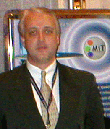|
|
 
|
|
Author
|
Topic: e-cinema
|
Philip Borgnes
Film Handler

Posts: 18
From: Seattle, WA, USA
Registered: Apr 2004
|
 posted 04-24-2004 12:32 AM
posted 04-24-2004 12:32 AM





Ran across this tidbit about e-cinema releasing in India. From what I read beyond this article is that Mukla Adlab has setup a network of over 100 e-cinemas in less then a year in India. I believe this is HD cinema at 1.9k.
http://infotech.indiatimes.com/articleshow/579959.cms
E-cinema: Coming soon to a theatre near you
APARNA KALRA
TIMES NEWS NETWORK[ WEDNESDAY, MARCH 24, 2004 05:36:03 PM ]
When the Bobby Deol-starrer `Bardashdt’ goes on-screen, it will be the first movie to be digitally distributed in India.
Slated for a mid-April 15 release, `Bardashdt’ will be transmitted from Bombay and Noida via satellite, to be downloaded by nearly 25 theatres in Delhi, Uttar Pradesh, Punjab & Haryana – four major film territories. The distribution of film via satellite will cut costs, reduce lag between a movie’s release and it’s screening in theatres especially in smaller towns, and usher-in a technological revolution.
So far film prints are physically transported to most cinema theatres in the country. “This is a move away from the traditional 35mm screen. Our technicians have gone to these theatres and ensured that they are ready for digital reception and screening of films,” said Sanjay Mehta, film distributor and co-owner of Dev Digital Cinemas, the company which is spearheading the digitalization move. Dev Digital Cinemas is a joint venture between Ginni Arts, Bobby Arts and AdLabs, Bombay.
`Bardashdt’ will be transmitted from Bombay and Noida via satellite, and will be downloaded by theatres, thus saving the costs of transport of films. “Instead of spending Rs 50,000 or Rs 60,000 per print, the costs will work out to Rs 5,000 to Rs 7,000 per theatre,” said Rajeev Gupta of Ginni Arts which owns Wave cineplexes in Delhi.
Earlier this year, Dev Digital Cinemas experimented with the satellite transmission of the movie `Kismat’. E-cinema will ultimately reach 150 cinema theatres in India.
| IP: Logged
|
|
|
|
|
|
|
|
|
|
|
|
Paul Mayer
Oh get out of it Melvin, before it pulls you under!

Posts: 3836
From: Albuquerque, NM
Registered: Feb 2000
|
 posted 04-25-2004 10:15 PM
posted 04-25-2004 10:15 PM





In today's Los Angeles Times Business section:
Theater's Front-Row Seat to Digital Future
The Pacific Hollywood, built to debut the breakthrough technology of its day -- talkies -- now has a new role: showcase and lab for the high-tech replacement of film at cinemas.
By Alex Pham, Times Staff Writer
It is said that the ghost of Sam Warner haunts the musty spaces of the Pacific Hollywood theater, snatching cellphones and pagers and Palm Pilots when their owners look away.
The forlorn movie palace, locked behind metal security gates in the heart of Hollywood, was Warner's dream, the first theater built expressly for talking pictures. The second-youngest of the four Warner brothers died at 42, never to see what the Los Angeles Times called the theater's "dazzling" opening in 1928 — or its long, slow slide into dereliction in the decades that followed.
Charles S. Swartz takes comfort in believing that Sam Warner's spirit, at least, may be watching over the theater's rebirth as a sophisticated test center for the next generation of movie technology.
"The idea that we are now on the cutting edge of giving movies their next life into the 21st century would absolutely thrill him," said Swartz, executive director of USC's Entertainment Technology Center, a research group backed by the major studios as they gird for the advent of digital cinema.
If cinema's tomorrow is taking shape in a relic of its past, it's happening without a lot of glitz. Unlike the other movie palaces along Hollywood Boulevard that have undergone costly face-lifts — notably the El Capitan — the theater is to most eyes not ready for its close-up.
Its now-dowdy Spanish Renaissance auditorium looks just as it did when the theater shut in 1994, with faux stars flickering in the ceiling, faded red velvet seat covers worn thin with age and garnet curtains framing the screen. It smells vaguely dusty and damp.
On the roof, though, is the future: a battery of satellite dishes. And along the back wall of the Hollywood's projection booth, a bank of 12 powerful computer servers blink furiously. Peering out at the five-story screen are three projectors: A high-end model by Kinoton able to handle 35-millimeter and 70-millimeter film and two high-resolution digital projectors, all cooled with a dedicated air conditioning system.
The $1 million worth of equipment represents a fraction of the $1 billion the seven major studios believe they can save annually by embracing a future without film, when movies shown in theaters will be the result of streams of 0s and 1s flowing either from a high-speed Internet connection or from optical discs.
That's years away. Many aspects of Hollywood production have already been digitized, from editing to special effects. Capturing and exhibiting the work remain almost exclusively film, though more and more productions are replacing film with digital cameras because it's easier and cheaper.
Converting theaters to digital remains the latest frontier for movies. By doing so, studios could save hundreds of millions of dollars currently spent on printing and distributing film. Plus, picture quality would remain perfect, unlike film, which degrades over successive trips through a projector.
Still years away, that transition is projected to be as significant for the movie industry as "The Jazz Singer" and the introduction of talkies was in 1927.
It was for "The Jazz Singer" that Sam Warner persuaded his brothers to spend their last $1.25 million to build the Warner Hollywood Theater. Sam was fascinated by technology and worked personally with Bell Laboratories to develop the sound technology for movies, technology for which Warner Bros. Pictures held exclusive rights.
The Warner Hollywood Theater was intended to showcase it, and Warner personally oversaw construction. But it became clear in 1927 that the movie palace wouldn't be ready for the premiere of "The Jazz Singer," which instead opened that October in New York.
The night before the premiere, Warner died of a brain hemorrhage. Six months later, when "Jazz Singer" star Al Jolson spoke at the opening of the theater, a plaque remembering Warner was unveiled in the lobby. Over the years, Marlene Dietrich and other Hollywood A-listers strolled past that plaque on their way to countless premieres.
Some of those films are now being premiered anew on the cinema's digital projectors.
"At Christmas last year, we screened 'The Adventures of Robin Hood,' " Swartz recalled. "In 1938, 65 years ago, that movie had its premiere in that theater, shot in Technicolor. Now we're showing the same movie digitally restored and digitally projected."
These days, the theater's patrons are more geek than glam. Instead of bearing diamonds the size of marbles, they bring tiny computer chips that drive $100,000 digital projectors.
Under the faux sky painted on the ceiling of the cavernous auditorium, Paul K. Miller, technical go-to guy for the USC center's digital cinema lab at the theater, held up one such chip recently. Packed on a 2-inch-square piece of silicon were 1.3 million mirrors that pivot on command to reflect light. The mirrors are so minute, and the spaces between them even tinier, that together they appear to be a single, smooth surface.
A single projector has three such chips, each reflecting either red, green or blue light, the three primary colors from which a rainbow of hues is possible. In the fast-moving digital age, though, the chip in Miller's hand has already been eclipsed by a chip that packs 2 million individual mirrors in the same 2 square inches.
One crisp Tuesday evening, the chips were the stars that 100 or so producers, cinematographers, motion picture engineers and directors came to gawk at. The occasion was the screening of test footage created specifically to push both film and digital technology to the limit.
Many in the audience still saw film as the gold standard for high-quality viewing. It has a familiar look and has been around long enough that people are comfortable using it. Still, digital technology is catching up fast enough to begin weighing the cost and benefits of both.
"Film is very good, but it's also expensive," said Swartz of the USC Entertainment Technology Center, which runs the lab. "They're easily scratched, they wear down over time, and they degrade when you make copies."
With digital technology, studios can make exact copies without compromising quality. And, unlike film, each showing doesn't degrade the quality of the movie, Swartz said. "The big question is how we can embrace this new technology and at the same time preserve the heritage of the past?"
On that Tuesday night, the screen was split into two, with film shown on the left and digital on the right. The images were identical, allowing viewers to compare the highest-quality film possible against the digital version.
At times, the digital version seemed sharper. Other times the film version appeared better. One viewer turned to his neighbor mid-screening and whispered, "Which one's digital?"
To the untrained eye, the shots would have been unremarkable — a tree swaying gently in the wind against a clear blue sky, confetti blowing out of a window, rain pelting cobblestone at night, a bride's face. There was no sound, no dialogue and no plot.
And yet the audience was riveted. The pictures were "crisp" and "snappy," some remarked later during a question and answer session. The colors were "saturated" and "lively," they said.
The event was sponsored by the Digital Cinema Initiative, or DCI, a consortium of seven movie studios: Walt Disney Co., 20th Century Fox, MGM, Paramount Pictures, Sony Pictures Entertainment, Universal Pictures and Warner Bros.
The studios formed DCI in 2002 to develop a common standard for distributing movies in digital form. Although the consortium is scheduled to release its minimum requirements this fall, it will be years before digital projection hits theaters. Converting from film to digital projection would cost U.S. theater owners billions of dollars, depending on the technology used.
Among the companies whose technologies are being tested for the DCI project are Microsoft Corp., Texas Instruments Inc., Boeing Co., and Sony Corp. With so much money at stake, involving some of the heaviest hitters in film and technology, the DCI project is being closely followed.
Roy Wagner, cinematographer for the television show "CSI: Crime Scene Investigation," is among those keenly interested in the digital distribution of entertainment. "CSI" is among the network television shows shot and broadcast in high-definition digital video.
Sitting in the theater, Wagner said he was feeling a wave of nostalgia: He had been a projectionist there decades ago. Wagner, 57, remembers the first day he worked at the theater in 1970. He came in two hours early to explore the nooks and crannies.
"I found that the ceiling had these beautiful clouds that looked like they were built to move and stars with little lights in them that could twinkle," Wagner said. "It was a magnificent theater, and it really conveys what old Hollywood must have been like. You think of all the films and all the laughter, happiness and the tears shed by people in that theater. It's a pretty organic environment."
He nearly missed his first shift because he was so enchanted "that I nearly forgot why I was there."
Carol Burnett worked at the theater in the summer of 1951 as an 18-year-old usherette, dressed in an ill-fitting black satin outfit and a fez. She was fired from the 65-cent-an-hour job when she tried to persuade a couple against being seated during the last 10 minutes of "Strangers on a Train."
"It had this terrific surprise ending, and seeing it would just ruin the movie for them," Burnett said. "But the manager came along, and he fired me on the spot. So years later, when they asked me where I wanted my star on Hollywood Boulevard, I said, 'Right in front of the Warner theater!' " And that's where it went.
Shortly after Burnett's tenure, a curved Cinerama screen was installed. In the 1970s, new owner Pacific Theatres Corp. blocked off and divided the balcony to make the theater a triplex and replaced the Warner name with its own on the marquee. The theater was shut to the public after the Northridge earthquake and subway tunneling were blamed for making parts of the building unstable.
In 1999, USC leased the movie house from Pacific Theatres for an undisclosed amount. Pacific, which shut the theater in 1994 after the earthquake left the upper balcony unstable, had been using it for storing old seats, projectors and sundry equipment.
USC spent three days cleaning out the dust but did little else to change its aesthetics. Instead, the school focused its resources on creating a state-of-the-art projection room with the wiring necessary to accommodate the flow of computers and equipment that are brought in for testing, removed and replaced.
Although restoring the theater to its original glory would be too costly for USC, the school does plan to continue its high-tech work as long as there's a demand for such services from the movie industry. Given the controversial nature of digital cinema, that's likely to amount to years of work for the school.
"Technology has always been a part of cinema," Swartz said. "And it always will be."
It's a dictum Sam Warner certainly believed as he worked to develop and install the sound system in his theater, a system he never got to see work because of his death. As the decades rolled by, the tale of Warner's unsettled ghost haunting the theater circulated.
Miller — a no-nonsense, stout man of 59 who speaks in short, direct sentences, acknowledges that strange things have happened there.
"You're standing there alone, and you know no one else is in the building, but you hear your name called," Miller said. "You put a tool down, and it winds up missing. You lose stuff. Lights flash on and off. Doors open and close.
"It hasn't happened in a while, but when we've had screenings for the public, we'd lose gadgets," Miller said. "We think he likes technology."
#####
| IP: Logged
|
|
John Pytlak
Film God

Posts: 9987
From: Rochester, NY 14650-1922
Registered: Jan 2000
|
 posted 04-26-2004 08:41 AM
posted 04-26-2004 08:41 AM





The Kodak Digital Cinema team uses a theatre in Rochester that has almost the exact same "footprint" as the USC Entertainment Technology Center (ETC) theatre in Hollywood.
The Kodak "Theater on the Ridge" in Rochester is a 2000 seat theatre that was built in the mid 1950's for activities like employee meetings, family film screenings, and stockholders meetings. The original projection room was above the balcony, with a steep down angle for projection.
A few years ago, I was involved in renovating the theatre, such that the projection room was relocated to the main floor, with ample room for multiple projectors to allow critical comparison of film and digital projection, just as in the ETC theatre. We installed a 63 x 25 foot Harkness Hall Matte White Plus MP screen, that can be "flown" when the theatre is used for live stage shows:
http://www.harknesshall.com/n0600_6.htm
quote:
Theatre screen doubles as test facility
NEW SCREEN FOR KODAK THEATRE
Kodak’s showpiece ‘Theatre on the Ridge’ in their headquarters town of Rochester Ny, USA has recently installed a brand new Harkness Hall screen.
Built as part of Kodak’s recreational facilities and what must be one of the world’s largest corporate theatres, the near 2000 seat auditorium boasting a huge 12.3 deep x 24.4mtr wide (40' x 80') stage area and full orchestra pit is a venue for both film and live theatre.
Not only was the new screen to be the focal point for entertainment shows but the Professional Motion Imaging Division at Kodak wanted it to double as a test facility in their development programmes. Receiving the specification for a ‘mid-gain’ screen from Kodak’s John Pytlak we submitted our Matt White Plus surface in new MP (mini-perf form) and waited for the test result.
We’re pleased to say the material perfectly met the requirements as the photographs show.
The 19.4 x 7.7mtr (63' x 25') screen was installed by Kodak engineers Daryl Jones and Jim Orefice, ‘overseen’ by Stan MacEachen of CDN Theatre Chair and Screen Installation.
No reports of any ghosts in the Kodak theater, not even "travel ghosts". ![[Wink]](wink.gif)
| IP: Logged
|
|
|
|
All times are Central (GMT -6:00)
|
|
Powered by Infopop Corporation
UBB.classicTM
6.3.1.2
The Film-Tech Forums are designed for various members related to the cinema industry to express their opinions, viewpoints and testimonials on various products, services and events based upon speculation, personal knowledge and factual information through use, therefore all views represented here allow no liability upon the publishers of this web site and the owners of said views assume no liability for any ill will resulting from these postings. The posts made here are for educational as well as entertainment purposes and as such anyone viewing this portion of the website must accept these views as statements of the author of that opinion
and agrees to release the authors from any and all liability.
|

 Home
Home
 Products
Products
 Store
Store
 Forum
Forum
 Warehouse
Warehouse
 Contact Us
Contact Us




 Printer-friendly view of this topic
Printer-friendly view of this topic









![[puke]](graemlins/puke.gif)

![[thumbsdown]](graemlins/thumbsdown.gif) It's akin to trying to show a 8mm print on a 30-foot screen and calling it a professional presentation.
It's akin to trying to show a 8mm print on a 30-foot screen and calling it a professional presentation. ![[Roll Eyes]](rolleyes.gif)

![[Wink]](wink.gif)



